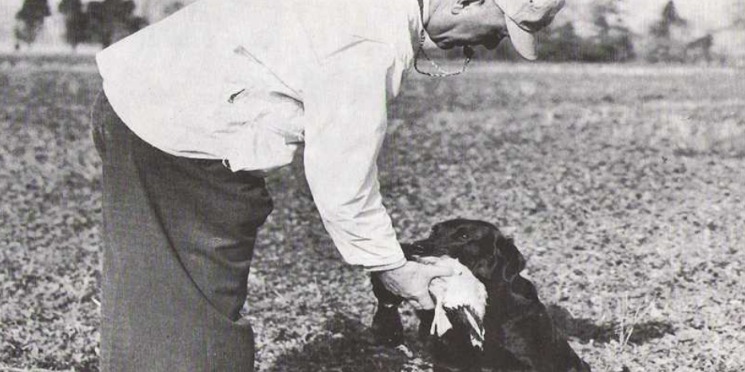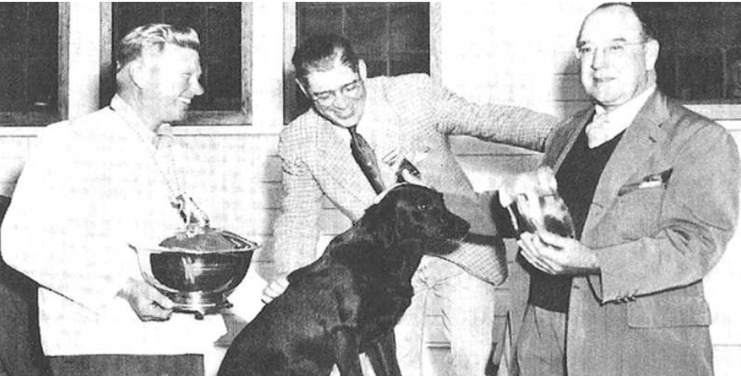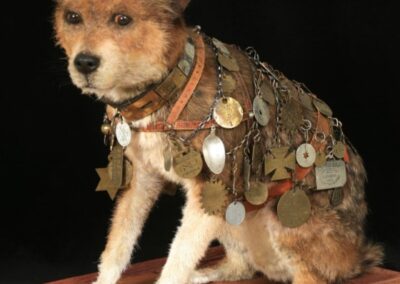
On a blustery night in rural Iowa in 1948, something extraordinary stirred in a litter of Labrador puppies. Among them was a fragile, sickly pup who looked destined for struggle rather than glory.
That pup—born the same day, oddly enough, as the boy who would train him decades later—would defy expectation and become King Buck, one of the most legendary retrievers in history.
And at his side stood Cotton Pershall, the trainer whose life would intertwine with Buck’s in a story of grit, vision, and legacy.
A Frail Pup with a Fighting Heart
Buck’s early days were anything but promising. From the moment he entered the world, illness shadowed him. He developed distemper, lost weight, and could barely stand.
Most would have written him off. But not Robert Howard, who took Buck into his Nebraska basement, wrapped him in blankets near the furnace, and fed him what he could—including raw egg—while praying the pup’s spirit would hold firm.
Against all odds, Buck stood. He trembled. He survived. He clawed his way forward. A vet warned he had a weak heart.
But Buck—lean, determined, ringed in weakness—refused to crumble. Instead, his suffering tempered him. His intelligence flickered alive. His desire sharpened.
Howard gave him a name: “Buck,” a call not easily confused with training commands.
Later, hearing people whisper “king,” he added the title “King Buck.” And every bit of that name would come to matter.

Enter Cotton Pershall — The Dog Man Born Two Generations Later
Cotton Pershall was born April 3, 1914. He grew up forging iron, riding saddle horses, and absorbing lessons from the land.
His first jobs brought him close to hunting clubs, retrievers, and wild birds. He trained a golden retriever named Rip, and Rip won national honors in 1939 and 1940 under his guidance.
Cotton believed in two things above all: intelligence and desire. He saw them in Buck. He believed Buck’s temperament could overcome the fragility his medical history imposed.
When Buck—now owned by John Olin—entered Cotton’s world, doubts circled, but Cotton held firm faith. He believed the dog could carry more than expectations.
Over the years, Buck and Cotton built a partnership that would define retriever training.
While others judged Buck’s health, Cotton trained through trust, repetition, and respect. The dog’s early struggles became the resolve behind his strength.
Rising Through Trials, Defying Opinions
In 1951, Buck began to prove the skeptics wrong. In dog trials, he began winning licensed derbies and field competitions. His raw potential blossomed when matched with Cotton’s steady hand.
By the time Buck was two, his record already strained restraint. Judges began asking, “How can one dog do so much, despite so little?”
Critics once whispered that Buck was “merely a runner” without the brain or steadiness for top-tier competition. A judge mocked the idea that Buck would ever “amount to a damn.”
Meanwhile, Cotton doubled down on patience. Buck’s strengths lay in water, smell, drive—the integration of instinct and training. And when the pressure mounted, Buck delivered.
He won open trials, edged out rivals, and made his case not by defying norms, but by becoming the norm for excellence.
At one fateful national trial in 1952, Buck exerted nearly flawless performance across trials, earning 99/100 on a standardized series.
He won, decisively. He became King Buck, not by inheritance, but by mastery.

Legacy Carved in Stone (and Bronze)
As Buck aged, his greatness grew. He continued competing, winning trophies and capturing hearts. Cotton estimated Buck completed 63 straight series across seven National Championship Stakes.
No retriever had ever done such a thing.
In his final years, Buck slowed, suffering arthritis, dehydration, and wear. Cotton and Olin chose to ease his passage—dignified, slow, as he lay in honor. He passed in 1962, just shy of his 14th birthday.
He was buried in front of Nilo Kennels, crowned with a full-size statue. A tumulus raised over his grave, honoring the dog who became myth.
Art immortalized him: Buck’s likeness appeared on a Duck Stamp, a symbol that tied field retriever heritage to wetlands and wild duck conservation.
Even as an image, King Buck continues to inspire.
Cotton went on to train other champions—28 in total—but he always said he had never seen a dog like Buck again.
He would say, “I ain’t seen a dog that could even smell where he’s been… Doing anything else.” Those words echo still.
Why This Story Matters to You (Not Just Hunters)
If you raise, train, or love dogs, Cotton and the King offers a lesson: great dogs are rarely built from comfort. They rise through trials, belief, consistent care, and trust.
Cotton didn’t force Buck to be perfect. He revealed what was already there. He showed how patience and respect can coax greatness from imperfection.
If your dog struggles, if odds are stacked, don’t give up. Every setback is part of the layering.
Sometimes the dog with a “bad start” holds the deepest championship in his bones.
Legends aren’t born—they’re chosen. Cotton chose Buck. Buck chose greatness.
And so, two lives separated by 34 years wound together in one story of legacy, performance, and eternal inspiration.



